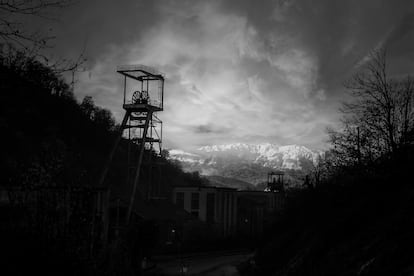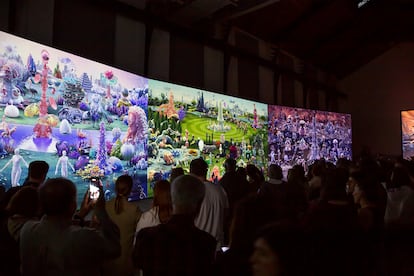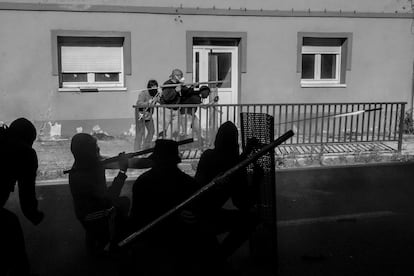From coal to video art: culture is the "well that never closes" of Asturian mining

Two small towers rise in the narrow Turón Valley, in the municipality of Mieres, Asturias, between the river and the road, nestled in the thick chestnut groves. It's the Santa Bárbara Well , which is celebrating its anniversary: 30 years ago, in 1995, coal mining stopped here. There have been no industrial sounds for a long time: just the wind blowing through the branches, the water running in the river, the occasional passing car, not many.
Mining had begun in 1913, always linked to Basque industrialists who used the coal for the steel industry. Minerals were extracted here, and 115 miners died here. After its closure in 2008, it was declared a Site of Cultural Interest (BIC). “Now and in the future, we must recognize ourselves in the workers who came before us: we owe the miners,” says guide María Fernanda Fernández. Since 2021, it has been a center for artistic interventions, the PZSB, curated by LEV (Visual Electronics Laboratory): the intervention Speculum by the Smack collective , a video art recreation of Hieronymus Bosch's The Garden of Earthly Delights , has just closed.
The Santa Bárbara Well's adventures are illustrative of the future of Asturian mining areas: from the backbone of the economy, Spain's industrial hub, the cradle of the labor movement, a source of identity and pride, to the need to retrain in the face of an uncertain future using the tools available: the valuable heritage, history, and culture. And tourism, invigorated by the questionable idea that climate refuges exist. And Asturias is one of them. Mining is gone, but somehow it's still there. There's pride in the legacy we inherited, but also a sense of uncertainty, of final defeat, of failure due to a poorly managed deindustrialization that never found a light at the end of the tunnel.

“We are the first generation in 150 years that hasn't had a life directly linked to mining, and at the same time, we are the last who were able to see it with our own eyes,” says writer and journalist Aitana Castaño, who grew up surrounded by mines and miners, as well as strikes and barricades. In her books, she tries to keep the flame alive for the new generations: the trilogy consisting of Carboneras , Los niños de humo, and Los niños de humo. and Traces of Ash (Silver Fish), where, with illustrations by Alfonso Zapico, she recalls different aspects of the mining industry, such as the perspectives of children and women. They are read in the institutes of the river basins, which is why the kids recognize her on the street.
Since the mid-19th century, coal has brought railroads, steelmaking, ports and shipyards, and a thriving subsidiary industry. But the mineral that waited in the depths also became a pillar of the basins' identity and, therefore, of the region: the bedrock of its emotional geography. "Everything comes from the mine," it was said. Now, nothing comes out, but much remains. "The mining character or condition of these spaces and their inhabitants endures, despite the fact that mine closures have been occurring uninterruptedly since the 1990s," writes historian Irene Díaz in her recent book Las cuencas mineros de Asturias: la crisis y sus narrativas (Trea) .
There is a physical persistence, in the form of headframes, buildings, or waste dumps, but also intangible traces that refer to the lived experience. A "distant closeness," in Díaz's words, that "allows us to approach the consequences and legacies of this process of industrial ruination for people, communities, and spaces." An "ultra-life ," as the historian calls it, also co-director, with Rubén Vega, of the documentary "Cultural Memories of an Industrial Past ." The final closure, with a few exceptions, occurred in 2018. The death in April of five miners in the Zarréu mine , who were on research leave, reminded us that some were still there, boring into the earth. Once again, the firedamp.

In terms of physical persistence, part of the valuable industrial heritage is now used for tourism and cultural purposes, not only the Santa Bárbara Shaft, but also the Samuño Mining Ecomuseum in Langreo, or the Sotón Shaft in El Entrego, which you can descend into, dressed in overalls, helmet, and lamp, on a demanding five-hour visit , to a depth of more than 500 meters. The Steel Museum (MUSI) is now housed in a former steel industry in La Felguera, and the Asturian Mining and Industry Museum (MUMI) is located in a waste dump of the San Vicente mine in El Entrego. Thus, economic activity gradually became museum material. Or something else: research is underway into how to use the shafts for underground greenhouses or computer server centers. There's a lot of space in that hollowed-out subsoil.
Feeling of emptinessThe decline of mining is captured in Asturias minada , the photography project by Álvaro Fuente, who first became interested in the project in 2012, on the occasion of a report on the centenary of the Mining Rescue Brigade. The photographer recalls the "feeling of emptiness" and the hardship the first time he descended into the famous María Luisa shaft, as well as the sense of solidarity that escapes from the underground and permeates the culture of the Cuencas region. "In the mine, you depend on your colleagues and problems have to be left outside. From the beginning, I was fascinated by that connection... to the point of soaping each other's backs, a gesture that seemed very expressive of camaraderie," he says. Perhaps that connection was what made a society that attracted thousands of people from many parts of Spain and Portugal in a very short time come together so quickly; because the Cuencas region is pure Asturias, but not so many have four Asturian grandparents.

Fuente's photos show the depth of the tunnels, but also the struggles on the surface. That year, 2012, was highly contentious: a march on foot to Madrid, roadblocks, riots, slingshots, charges, and races: the miners were always a tough nut to crack for the police (we're talking about people working underground with heavy tools and explosives), and they were again so then, when the imminent closure of the mines was announced, a process also chronicled by Marcos M. Merino in the film "Remine, el último movimiento obrero" (Remine, the Last Workers' Movement ).
Strike and revolutionBut the Revolution of 1934 is the culmination of the Asturian mining epic, above other milestones such as the strike of 1917 or those of the 1960s. The successful graphic novel series The Ballad of the North is dedicated to this historical milestone. (Astiberri), by Alfonso Zapico. The Civil War in Asturias is covered in the Republican Trilogy , a series of films and expanded scripts (in book format, published by Pez de Plata) by Ramón Lluis Bande. More specifically, Cantares para una Revolución , a musical documentary that recovers the memory of '34 through its songs, with the musician Nacho Vegas . A reminiscence of struggles and revolutions is also the concept of the resistance fund: thus, Caja de Resistencia , is the name given by the Mieres City Council to its series dedicated to cultural expressions censored in right-wing city councils. Creators such as Pedro Pastor, Rocío Saiz, Paco Becerra, Alberto Conejero, and Bob Pop have appeared. "We took that term from the working-class sphere to create a safe space for freedom of expression and creators," says Rocío Antela, Councilor for Culture... and former miner.

There are traces of mining in contemporary music as diverse as the now-defunct industrial group Fasenuova or the artist María Valle Roso, or in some songs by the classic rock and punk combo Dixebra (such as the anthem Mañana fría ). Literature has delved into the depths at least since the classic La aldea perdida (The Lost Village) by Armando Palacio Valdés, which, published in 1903, mournfully recounts the transformation of the rural world into an industrial one, from green Asturias to black and red Asturias, with the arrival of the mine. But that tradition continues, as seen in El palacio azul de los ingenieros belgas (The Blue Palace of the Belgian Engineers ) by Fulgencio Argüelles, a beautiful, tender, almost cult-like book set in the 1920s.
There are other perspectives: in How the Mountain Is a God (Pepitas de Calabaza), Eduardo Romero intelligently draws unusual connections with Latin America and the phenomenon of migration, both then and now, in both directions. Romero points out the possibility of remembering "without condoning industrialism, developmentalism, and extractivism. There is no contradiction in unraveling the destructive dynamics of fossil capitalism while simultaneously rescuing the memory of those who risked their lives by going down the well and wresting labor and social rights from their bosses and the state. If we manage to depatriarchalize that memory, the task will be complete."
And there weren't only mines in Asturias: in Hijos de carbón (Alfaguara), Noemí Sabugal from León gives a broad overview, combining her childhood memories in a mining family with a journey through different mining sites in Spain: also Galicia, León, Palencia, Córdoba, Teruel.

“A collective consciousness and a way of seeing the world were created around the mine; also, on another level, a certain confidence in the future and tremendous respect for culture. It's no wonder mining areas are prone to art: we've been angry, disenchanted, and forced to emigrate for several decades…” says Langreo poet Fruela Fernández, whose poetry collections, such as Una paz europea (A European Peace ) (Pre-Textos) and La familia socialista (The Socialist Family ) (La Bella Varsovia), are informed by the experience of growing up in the basins. “In a way, the basins are an intuition of the future for many territories in Europe,” he adds. An uncertain future: for the basins… and for the entire world.
“It's likely that the mining identity will fade,” concludes Aitana Castaño, “but it's our obligation to ensure it endures. Thousands of people came to the mines to work their tails off and make a better life for their families… even if it's just to honor those people, we have no choice but to defend the mineta identity. And, as philologist Benigno Delmiro says, literature, culture, is the well that never closes.”
EL PAÍS



%3Aformat(jpg)%3Aquality(99)%3Awatermark(f.elconfidencial.com%2Ffile%2Fbae%2Feea%2Ffde%2Fbaeeeafde1b3229287b0c008f7602058.png%2C0%2C275%2C1)%2Ff.elconfidencial.com%2Foriginal%2Ff66%2Fafe%2F737%2Ff66afe737fb6a76507cd4cd13dfaf350.jpg&w=3840&q=100)

